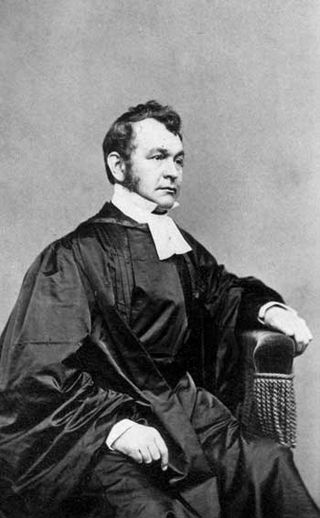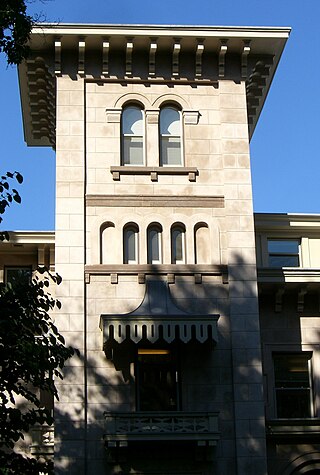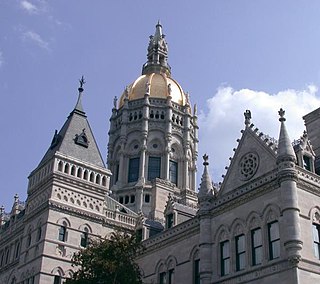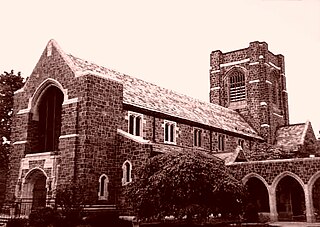
Hartford is the capital city of the U.S. state of Connecticut. The city, located in Hartford County, had a population of 121,054 as of the 2020 census. Hartford is the most populous city in the Capitol Planning Region and the core city of the Greater Hartford metropolitan area.

Ithiel Town was an American architect and civil engineer. One of the first generation of professional architects in the United States, Town made significant contributions to American architecture in the first half of the 19th century. His work, in the Federal and revivalist Greek and Gothic revival architectural styles, was influential and widely copied.

The Wadsworth Atheneum is an art museum in Hartford, Connecticut. The Wadsworth is noted for its collections of European Baroque art, ancient Egyptian and Classical bronzes, French and American Impressionist paintings, Hudson River School landscapes, modernist masterpieces and contemporary works, as well as collections of early American furniture and decorative arts.

Arthur Cleveland Coxe was the second Episcopal bishop of Western New York. He used Cleveland as his given name and is often referred to as A. Cleveland Coxe.

Austin Organs, Inc., is a manufacturer of pipe organs based in Hartford, Connecticut. The company is one of the oldest continuously-operating organ manufacturers in the United States. The first instruments were built in 1893 with the Austin Patent Airchest, and many remain in fine playing condition to this day.

William Croswell Doane was the first bishop of the Episcopal Diocese of Albany in the United States. He was bishop from 1869 until his death in 1913.

The Stowe Center for Literary Activism is a history museum and National Historic Landmark at 73 Forest Street in Hartford, Connecticut that was once the home of Harriet Beecher Stowe, author of the 1852 novel Uncle Tom's Cabin. Stowe lived in this house for the last 23 years of her life. It was her family's second home in Hartford. The 5,000 sq ft cottage-style house is located adjacent to the Mark Twain House and is open to the public. It was listed on the National Register of Historic Places in 1970, and declared a National Historic Landmark in 2013.

Henry Austin was a prominent and prolific American architect based in New Haven, Connecticut. He practiced for more than fifty years and designed many public buildings and homes primarily in the New Haven area. His most significant years of production seem to be the 1840s and 1850s.

The neighborhoods of Hartford, Connecticut in the United States are varied and historic.
Edward Tuckerman Potter was an American architect best known for designing the 1871 Mark Twain House in Hartford, Connecticut. With his half-brother William Appleton Potter, he also designed Nott Memorial Hall (1858–79) at his alma mater, Union College, Schenectady, New York. Both the Mark Twain House and Nott Memorial Hall are National Historic Landmarks.

The Hartford Public Library serves the city of Hartford, Connecticut, United States. The library's main branch is located at 500 Main Street in downtown Hartford. The nine branch locations are named Albany, Barbour, Blue Hills, Camp Field, Dwight, Goodwin, Mark Twain, Park and Ropkins. All branches feature free public access computers and free Wi-Fi.

The Church of the Good Shepherd and Parish House is an Episcopal church at 155 Wyllys Street in Hartford, Connecticut. It was commissioned by Elizabeth Jarvis Colt, the widow of Samuel Colt, and completed in 1867. The church and its associated parish house were designed by Edward Tuckerman Potter, and serve as a memorial to Samuel Colt and members of his family. The church and parish house were added to the National Register of Historic Places in 1975, and became a contributing property to the Coltsville Historic District in 2008.

The Basilica of the Immaculate Conception is a Roman Catholic church located at 74 West Main Street in Waterbury, Connecticut.

St. John's is an Episcopal Church located at 679 Farmington Avenue in West Hartford, Connecticut near the Hartford, Connecticut, city line. The parish was founded in 1841 as St. John's Episcopal Church in Hartford. The church's present building, designed by famed architect Bertram Grosvenor Goodhue, opened in 1909. It is noted for its reredos designed by Mr. Goodhue and executed by prominent sculptor Lee Lawrie; its organ, Opus 2761 by Austin Organs, Inc., with 64 ranks and 3721 pipes; and its thirty-six stained glass windows by designers/manufacturers such as the Harry Eldredge Goodhue Company of Cambridge, Massachusetts, Wilbur H. Burnham Studios of Boston, Massachusetts, and London, England's James Powell and Sons.
St. Joseph is a Roman Catholic church in Danbury, Connecticut, part of the Diocese of Bridgeport.
The following is a timeline of the history of the city of Hartford, Connecticut, USA.

Elizabeth Jarvis Colt was the widow and heir of firearms manufacturer Samuel Colt, founder of Colt's Manufacturing Company.

The Hartford Times Building is an architecturally significant, early 20th-century Beaux-Arts style building in downtown Hartford, Connecticut, completed in 1920 as the headquarters of the now defunct Hartford Times. The newspaper commissioned architect Donn Barber, who had designed the nearby Travelers Tower and Connecticut State Library and Supreme Court Building, to design a new structure to house its office and newspaper plant. At the time the paper was at the height of its influence with the top circulation in the state in 1917.

Grace & St. Peter's Church is an Anglo-Catholic Episcopal parish in the city of Baltimore, in the Episcopal Diocese of Maryland. The congregation is the product of the 1912 amalgamation of two earlier parishes, St. Peter's Church and Grace Church. Its building, constructed in Brownstone, is an elaborate example of English Gothic Revival architecture dating from 1852. Today, Grace & St. Peter's is distinguished by its Anglo-Catholic liturgy and professional choir. From 1940 to 2020, it was also home to the Wilkes School at Grace & St. Peter's, an Episcopal day school which closed in the midst of the COVID-19 pandemic.

















